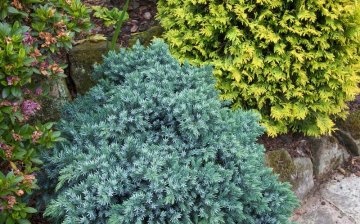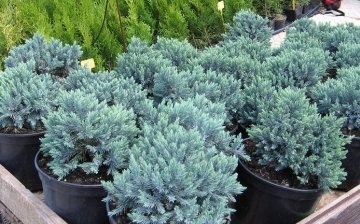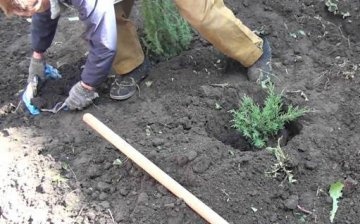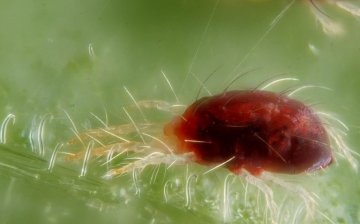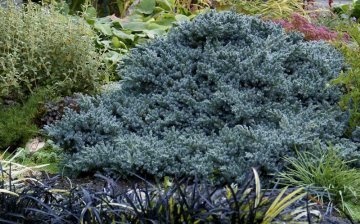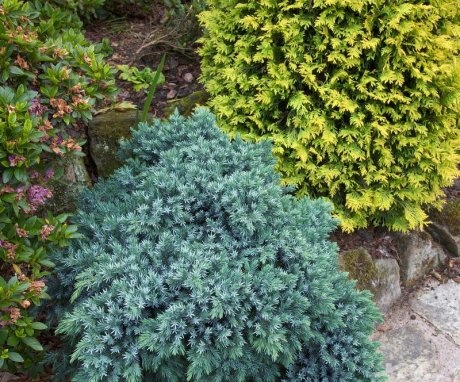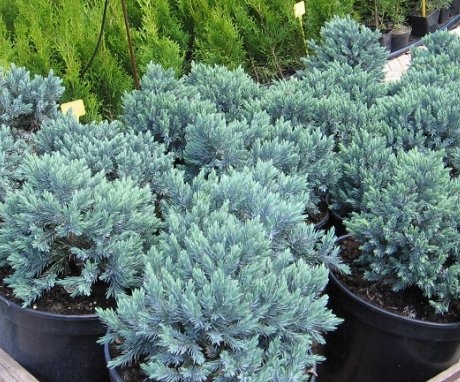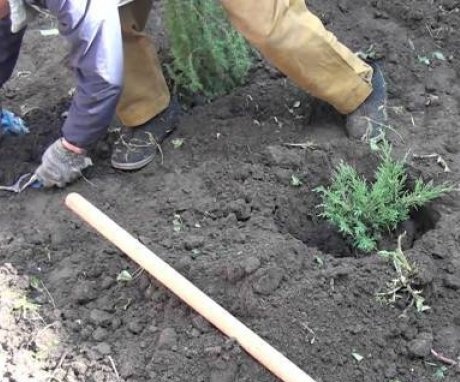How to grow Blue Star scaly juniper?
Many gardeners often use an interesting move on their backyards - they grow juniper... One of the decorative representatives is the scaly Blue Star. To grow it, you need to familiarize yourself with the rules of planting and care. The main thing is to determine in time when a disease or pests appear and eliminate them in time.
Content:
- Shrub description
- Reproduction methods
- Landing dates and rules
- Care Tips
- Disease and pest control
- Application in landscape design
Shrub description
The Blue Star juniper is the most common type of dwarf coniferous juniper. Its crown is dense, takes the shape of a dome. It is characterized by very slow growth - it does not stretch more than 8 cm upward per year.
Features of the structure:
- An adult plant is a small bush up to 70 cm high, growing in breadth up to 1.5 m. The plant reaches such volumes at the age of 30. At the age of 10 years, the bush grows only up to 30 cm in height and 50 cm in the sides.
- Juniper needles are prickly, short, some part may be covered with scales.
- Young spreading whips acquire a turquoise hue. As they grow older, the tone of the bush changes to a calmer tone - bluish-blue.
When planting, the juniper is not bothered by the soil on which it is placed. But best of all, it gains volume in fertile soil filled with nutrients and minerals. The plant is quite light-requiring, it tolerates bright sunlight well.
When placed in the shade, juniper dims, it practically does not grow.
Watering him also does not care, as does the soil substrate. It is strongly not recommended to transfuse the plant. Irrigation should be sparse and moderate. With an abundant supply of nutritious moisture, the plant quickly rots and disappears. Compact size allows you to root the plant in small flowerpots and decorate balconies, steps or decorative corners with them.
Reproduction methods
Juniper is a dioecious plant. Therefore, it can be grown not only with roots and cuttings, but also when planting seed. The disadvantage of growing with seeds is the lack of decorative effect in the shrub. It does not retain the qualities of the mother bush. Therefore, usually the dwarf shrub is grown using cuttings.
Cutting rules:
- Plants of the age period from 7 to 10 years are ideal for collecting planting material. It is recommended to carry out the pruning procedure in mid-April - early March.
- A branch is carefully separated from the bush with a sharp, disinfected garden knife or pruner. It should not exceed 7-10 cm, and at the end, preferably, grab a piece of wood from the trunk. Such a piece is called "Heel".
- The base of the cutting is carefully cleaned, all needles and twigs are removed from it. The outer bark is removed, exposing the inner trunk.
- Before planting, it is recommended to place the stalk in a solution with a growth stimulator to activate root system... The consistency should be kept for no more than 24 hours.After that, the seedling is placed in a specially prepared soil mixture. It should include river sand and dry peat.
- The pot with the handle should be placed in a warm room, while creating greenhouse conditions. This will help to release young roots faster and take root in a new place. From above, you can pull a plastic transparent bag or cover it with a cap. A plastic cup or cut bottle is perfect for this.
The seedling is placed in a semi-dark room with an optimal temperature for faster germination of new roots +20 C. Within 3-6 weeks, new young needles will appear. The process will mean that the stalk has successfully released the roots and engrafted. Now it can be planted in a larger flowerpot.
It is recommended to transplant to open ground only after 2-3 years. Until this moment, the shrub is covered with spruce branches in the winter. Such shelter measures for the colder months are optimal for frost-hardy junipers.
Landing dates and rules
Young plants are planted in the ground for rooting no earlier than the end of March. When planting a young shrub, you need to choose a warmer time. A warm, sunny spring day is perfect. A well-lit place for deepening should be chosen. If the bush is planted in semi-darkness or shade, then the juniper will grow semi-wild, spreading and not neat. It will completely lose its decorative shape.
If you need to plant several bushes next to it, you should retreat as much space as possible. The best option would be a gap between landings - 2 meters. The minimum allowable distance between cuttings is 0.5 meters. This is necessary due to the fact that when the plants begin to grow, they will interfere with each other.
Juniper is comfortable with any type of soil.
It grows normally on salty, waterlogged land. If there is a clay substrate, it is recommended to dilute it with drainage, and add a mixture of dry peat to others. The soil on which a young seedling develops best is loose, slightly acidic loam.
The following rules for planting Blue Star juniper are distinguished:
- A depression is dug into the ground, at least 70 cm deep. The width should be exactly 2 times more than the earthen lump in which the seedling is located.
- A drainage layer is laid out on the base of the pit. For this, either river sand or fragments of broken brick is selected.
- Landing is carried out by the transshipment method. So the plant will not notice that it has been moved from a closed flowerpot to open ground. At the same time, it will not hurt and acclimatize.
- When filling the soil, the root collar should not be closed, it should remain in the air, flush with the ground.
- In the case of a close location of groundwater, it is imperative to add a layer of 15 cm of large crushed stone to the drainage layer.
- For planting, a certain batch of soil substrate is prepared - peat, river sand and garden soil. All ingredients are taken in equal proportions.
A properly performed planting and a well-chosen place will allow the plant to quickly grow and please with new branches the next year. It all depends on the soil and organic fertilizers applied during planting. Although the culture can grow on depleted substrates, it will grow extremely slowly.
Care Tips
After planting, the juniper seedling needs to be watered abundantly for 7 days. For the rest of the growing time, the shrub needs simple care:
- Loosening.
- Fertilizer mineral and organic trace elements.
- Irrigation of the soil with life-giving moisture.
- Forming pruning and removal of dry or damaged growth.
- Insecticide control against pests and diseases of various origins.
Juniper does not like dry seasons, therefore, especially in the summer months, it needs moisture.In the rest of the year, when the air is sufficiently humid and the soil does not dry out, watering is applied once every 10-14 days. For growth, feeding is required. In the last days of April or in the first decade of May, fertilizer should be applied. To do this, use a full set of mineral fertilizers or simplify matters, feed them with nitroammophos. After the next dose of minerals falls on October.
The soil is loosened periodically. The procedure is important for a young seedling. Due to this, oxygen and nutrient moisture penetrate to the root system after watering. In addition, during the event, all weeds that peacefully settle near the base of the tree are eliminated.
Mulching - a mandatory procedure when caring for a juniper.
If it is carried out in the spring, then the bush will grow and develop much more intensively. In winter, laying out mulch will help insulate the root system and prevent it from freezing on cold days.
Disease and pest control
All plants, regardless of whether they are harmless or semi-poisonous, as is the case with juniper, are subject to invasion of pests and the attachment of pathogenic bacteria.
The main parasites inhabiting a young plant are:
- Shield
- Spider mite
- Miner moth
- Needle mite
- Aphid
It is almost impossible to cope with these pests with the help of folk remedies. The time spent fighting with the use of decoctions and solution will be irretrievably lost. To remove all parasites will help a chemical pest control - BI-58, Topaz, Karate, Fitoverm, Karbofos, Decis.
The disease most commonly affected by junipers is rust. The cause of the manifestation of the disease is animals that have the property of salting the soil under the plant. Because of this, red spots appear on the plants, which intensively begin to creep along the entire perimeter of the needles. As a result, complete dying off and shedding of needles is provoked. These growths are spores of a fungus that completely eats away the needles, turning them into dust.
The main factor for the onset of the disease is poor ecology, excessive soil moisture and a sharp decrease in temperature.
Often the period of appearance of a fungal disease occurs in May - early July. To eliminate the problem, it is recommended to spray the shrub with the Arcerida chemical insecticide. The procedure is performed once every 7 days until the smallest signs of the disease are completely eliminated. A substitute for the insecticide is copper sulfate. If not the entire tree is affected, but the process has just begun, then only those branches on which the disease is noticeable need to be eliminated.
Application in landscape design
Juniper is very popular with gardeners who are engaged in beautifying their personal plot:
- The culture is perfect for growing in mixborder, and on a multi-level flowerbed, as well as on an alpine slide.
- Due to the original color - blue tone and dense structure of the branches, the juniper stands out for its originality and ease of care. It perfectly sets off the contrast between coniferous and deciduous ornamental crops.
- In addition, the plant is used to decorate a winter garden, in cases where evergreen shrubs of various heights are gathered in a single flower bed. This application of culture will become the highlight of the winter and summer garden.
Juniper is a disinfectant and a unique antibacterial plant. Having landed it on the site, always clean air will be provided over a large area.
Thus, the culture is not only an original addition to decorating a personal plot, but also a remedy for disinfection of pathogenic bacteria. Simple care will allow you to grow a beautiful, aromatic and interesting plant effortlessly.
More information can be found in the video:




